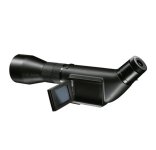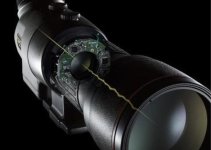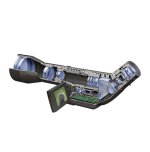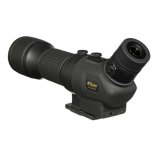-
Welcome to BirdForum, the internet's largest birding community with thousands of members from all over the world. The forums are dedicated to wild birds, birding, binoculars and equipment and all that goes with it.
Please register for an account to take part in the discussions in the forum, post your pictures in the gallery and more.
You are using an out of date browser. It may not display this or other websites correctly.
You should upgrade or use an alternative browser.
You should upgrade or use an alternative browser.
Wishes: a new scope like the AX Visio (1 Viewer)
- Thread starter steph.661
- Start date
More options
Who Replied?Coloradodipper
Active member

Not my cup of tea but a new eyepiece module could easily facilitate that.

Why? Swarovski have no experience with drones and very limited experience with cameras. One can already buy a drone from DJI, worlds leading drone maker, with a camera from Hasselblad, a renowned camera maker.a 'quiet' drone with swaro optiks, waterproof, and all modern options of a professional drone
DJI Mavic 2 Pro
MiddleRiver
Well-known member

I can't imagine the bino for my style of birding/travel. But the idea of a scope is intriguing! Even just an integrated camera. The fact that I'm putting it on a tripod anyway, or often used when traveling by car, negates most of my objections to size/weight.with integrated camera and stabilisation and/or with a thermal-imaging camera, distance measurement, gps, etc etc
or
a 'quiet' drone with swaro optiks, waterproof, and all modern options of a professional drone.
Nikon previously made the EDG VR (vibration reduction) Fieldscope and Zeiss made the Photoscope (Victory Diascope) with oboard camera. I believe both were a big flop. I suspect because of the astronomical prices and extreme weight.
I have previously had both the Victory a Diascope and the EDG Fieldscope without the electronics and both were fantastic scopes! However both were still very large and heavy WITHOUT any added electrical or mechanical components. I never saw the Photoscope or EDG VR in person.
It would be very neat to see this technology integrated into something lightweight and affordable for sure. Onboard AI to identify what you are looking at would definitely increase the cool factor but I think a function like “target lock” would be especially beneficial. Mark an identified item of interest that the AI keeps identifying even when it moves within the image. Drones have this capability, typically with integrated thermal imaging.
It seems suddenly I turned the simple spotting scope into a military tool 🤫.
I have previously had both the Victory a Diascope and the EDG Fieldscope without the electronics and both were fantastic scopes! However both were still very large and heavy WITHOUT any added electrical or mechanical components. I never saw the Photoscope or EDG VR in person.
It would be very neat to see this technology integrated into something lightweight and affordable for sure. Onboard AI to identify what you are looking at would definitely increase the cool factor but I think a function like “target lock” would be especially beneficial. Mark an identified item of interest that the AI keeps identifying even when it moves within the image. Drones have this capability, typically with integrated thermal imaging.
It seems suddenly I turned the simple spotting scope into a military tool 🤫.
Attachments
MiddleRiver
Well-known member

...which is to say that surely it already exists ;-)It seems suddenly I turned the simple spotting scope into a military tool 🤫.

Just get one of these...
 www.flir.co.uk
www.flir.co.uk
Recon® V Thermal Binocular with EO, Laser Rangefinder | Teledyne FLIR
The Recon® V is a compact and light yet rugged multi-sensor thermal binocular designed for 24/7 day and night field operations that require enhanced imagery and long standoff range. Its internal GPS, DMC, and long-range laser pointer provide accurate range to target as well as precise location...
A scope (well mounted) doesn’t need IS. I can add a phone adapter to the eyepiece and Merlin (as noted) can do the AI, so we’ve sort of already have what we’re after… though not with our eye down the eyepiece and having the info there in the view. Hugely inflating the asking price will reduce the sales, though maybe the intended market won’t care. I personally like wide (apparent) angle fields and (reasonably) higher power bright images so I can get close to what I’m looking at and see their personalities.
Peter
Peter
Jason Bugay Reyes
Well-known member

Nikon Fieldscope EDG85 VR Review Tested it for few months and the VR worked in windy condition etcNikon previously made the EDG VR (vibration reduction) Fieldscope and Zeiss made the Photoscope (Victory Diascope) with oboard camera. I believe both were a big flop. I suspect because of the astronomical prices and extreme weight.
I have previously had both the Victory a Diascope and the EDG Fieldscope without the electronics and both were fantastic scopes! However both were still very large and heavy WITHOUT any added electrical or mechanical components. I never saw the Photoscope or EDG VR in person.
It would be very neat to see this technology integrated into something lightweight and affordable for sure. Onboard AI to identify what you are looking at would definitely increase the cool factor but I think a function like “target lock” would be especially beneficial. Mark an identified item of interest that the AI keeps identifying even when it moves within the image. Drones have this capability, typically with integrated thermal imaging.
It seems suddenly I turned the simple spotting scope into a military tool 🤫.
Hermann
Well-known member

Another problem with the Photoscope was that the sensor of the camera module was already outdated when the Photoscope came onto the market. A shame, really, because the Photoscope was a brilliant scope.Nikon previously made the EDG VR (vibration reduction) Fieldscope and Zeiss made the Photoscope (Victory Diascope) with oboard camera. I believe both were a big flop. I suspect because of the astronomical prices and extreme weight.
As an aside: I am wondering about the sensor of the Visio. Sensor technology is still making some progress, albeit more slowly than in the past. Will it be possible to exchange the camera module for an up-to-date module in, say, 5 or 6 years?
Hermann
Honestly for a scope I believe any existing adapter that allows digiscoping with a a phone is the answer. Changeable camera options (upgrade of phone) with onboard AI that can identify via sound and visual applications. It just requires the user to have a smart phone. The scope stays as is and the phone is the changeable module.Another problem with the Photoscope was that the sensor of the camera module was already outdated when the Photoscope came onto the market. A shame, really, because the Photoscope was a brilliant scope.
As an aside: I am wondering about the sensor of the Visio. Sensor technology is still making some progress, albeit more slowly than in the past. Will it be possible to exchange the camera module for an up-to-date module in, say, 5 or 6 years?
Hermann
Maybe a link between the phone and mirrorless cameras is next (maybe it exists?).
grackle314
Well-known member

I use ATX/BTX with adapter for Samsung S22 Ultra. Mostly I use the BTX for the digiscoping, looking through one eyepiece while the phone is on the other. Quality of the pictures is variable as my photo skills are not honed well. I do get a few shots which sparkle for me and a lot of shots which help identification details later, particularly for eBird postings on uncommon birds. And the Merlin app makes useful suggestions in the ID process, supplemented by the Sibley app.
Just some kind of stabilised version of the ATC/STC would be enough of a scope technology upgrade for me, if it would mean that it would really be useable without tripod, not just according to marketeers.
(Though I'm not sure if it would work well enough, and the price would probably be set absurdly high.)
The phone would do the rest if I'd want some picture.
(Though I'm not sure if it would work well enough, and the price would probably be set absurdly high.)
The phone would do the rest if I'd want some picture.
Jason Bugay Reyes
Well-known member

I use ATX/BTX with adapter for Samsung S22 Ultra. Mostly I use the BTX for the digiscoping, looking through one eyepiece while the phone is on the other. Quality of the pictures is variable as my photo skills are not honed well. I do get a few shots which sparkle for me and a lot of shots which help identification details later, particularly for eBird postings on uncommon birds. And the Merlin app makes useful suggestions in the ID process, supplemented by the Sibley app.
Did you find it easy for digiscoping with the BTX? What kind of adapter for the Samsung?
Vollmeise
Well-known member
The AX Visio doesn't use the bino's optics to take the photo. It uses a digicam with it's own tiny lens attached centered on top. The digital aids and ultimately the species ID are reflected into the optical system in the right tube.Not my cup of tea but a new eyepiece module could easily facilitate that.
That's why the path to a digital eyepiece will be a long one; after all, no one wants to miss out on the high optical quality of their spotting scope.
On the other hand, a digital eyepiece without sacrificing optical quality doesn't seem impossible to me; the extremely high-resolution viewfinder of my Sony A7R5 already shows where the journey could go.
grackle314
Well-known member

Samsung Ultra S22 for me is in the Samsung leather case. That case basically does not come off the phone. I use the Swarovski VPA variable phone adapter with BTX and ATX clamps. I find the VPA was difficult at first to get the S22 into it as the S22 is right at maximum acceptable width. At first I switched to using a Samsung Note 9 since it fit easily into the VPA. With a few hours of use the VPA would accept my S22 (which has a better camera than the Note 9) by sliding it in from the top of the width-controlling bracket. The VPA alignment must be made with the camera lens choice in mind since the S22 has several lenses depending on photo selection. And for me the VPA is not too securely attached when using the ATX, I am cautious when using it on the ATX. The VPA clamps down on the BTX well enough.Did you find it easy for digiscoping with the BTX? What kind of adapter for the Samsung?
Next week I will pick up a VPA 2 variable phone adapter I ordered, with a design I find improved from the VPA.
I'm hoping you are wrong: I tried digiscoping, found it disturbing (as in interrupting my birding), and when the phone finally got into place I'd get a call 😥Honestly for a scope I believe any existing adapter that allows digiscoping with a a phone is the answer. Changeable camera options (upgrade of phone) with onboard AI that can identify via sound and visual applications. It just requires the user to have a smart phone. The scope stays as is and the phone is the changeable module.
Maybe a link between the phone and mirrorless cameras is next (maybe it exists?).
So I got an AX...
Per
Users who are viewing this thread
Total: 2 (members: 0, guests: 2)









